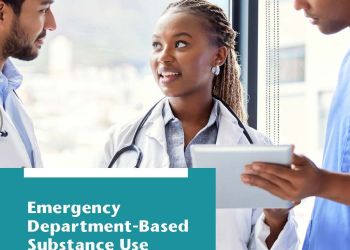
Image Description: The diverse group of people, entrepreneurs, or office workers isolated on white background. (Stock image)
To help build better community partnerships to address the public health needs of people with disabilities, building an inclusive workplace for people with disabilities is an important step. In this blog post, we will provide an overview of disability inclusive workplaces and steps that local health departments can take to build a more inclusive workplace culture for people with disabilities, specifically around retention, accommodations, hiring, and recruiting.
Definition of Disability and Disability Fluidity
In the U.S., about 1 in 4 adults have a disability. The American with Disabilities Act covers people with physical and mental impairments that affect major life activities, have a record or history of the impairment(s), and people who are perceived to have an impairment. This broad definition means there are many different types of disabilities that people may have, such as post-traumatic stress disorder, seasonal affective disorder, cancer, diabetes, or hearing loss.
Disability is also not as rigid or dichotomous as many people may think. Some people are born with a disability and other people acquire a disability later in their life. People with a disability may have situations or times during the year where their disability is more pronounced or visible, such as with seasonal affective disorder or multiple sclerosis, or someone may experience a situation or traumatic event that results in an impairment such as hearing loss or post-traumatic stress disorder.
Importance of Inclusive Workplaces
Disability inclusive workplaces have been shown to improve retention of employees, improve connections with communities, and increase innovation. It takes a team to build a disability inclusive workplace starting with employers who foster a culture built on respect and empathy. Being intentional about including people with disabilities in decisions, especially about accommodations and their work, helps to build a more inclusive workplace where people can participate and innovate.
One example of building a more inclusive workplace for people with disabilities is the National Institutes of Health (NIH). NIH is working to expand their work to better include people with disabilities, as both staff and researchers as well as populations included in studies. With this new focus, NIH is working to better understand and support the diverse needs of employees and communities with disabilities to innovate and provide better health outcomes for people with disabilities.
Accommodations
Oftentimes, supervisors and managers are the first among employers to receive an accommodation request, not human resources. Asking for a workplace accommodation can be stressful for employees because they do not know how their accommodation request will be perceived and they do not want to feel like they are getting special treatment or are unable to do their job. For people with invisible disabilities, such as many veterans, it can be even more challenging to make an accommodation request. Building an environment that fosters safety when requesting accommodations can help build a positive workplace.
In their 2020 survey, the Job Accommodation Network found that 56% of accommodations did not cost the employer anything, worker productivity increased, employers had a decrease in new staff training because they retained more staff, interactions between co-workers improved as well as overall morale, and they had improved safety. The Job Accommodation Network provides many recommendations on accommodations for a variety of disabilities, limitations, and workplace settings as well as free consultations for employers on how to provide accommodations.
Steps Local Health Departments Can Take
For managers, it is important to review policies on recruiting, retention, and job qualifications to make sure they are not unintentionally excluding qualified applicants and make it easier for people to request an accommodation. It is also important for supervisors and managers to be available to your teams and to learn from them. Consider how you recruit for your positions and where you might expand your search, such as working with your local veterans’ services office, the network of local agencies serving people with disabilities, local vocational rehabilitation case managers, offering internships, or through a local or regional university office of disability services.
If you are not a manager, consider how you can build your understanding of disabilities and disability culture. When developing programs or activities, take the time to build relationships with people with disabilities and agencies that serve people with disabilities. As a co-worker, consider how you can be more empathetic with your colleagues or support more disability inclusive hiring and retention policies. There is also a need for best practices and research on disability inclusive public health programming, so consider how you can collaborate to build this area of public health practice.
We have a lot of opportunities to learn from each other as we build healthier and more resilient communities.
Additional Resources
The U.S. Department of Labor and U.S. Department of Justice have a variety of resources for disability inclusive hiring, recruiting, retaining, and accommodations. Here are a list of resources:
- You can access the Job Accommodation Network for a free workplace accommodation toolkit, information about common disabilities and example accommodations, or request a free consultation.
- If you would like more information on the ADA and the updated website, you can start with the Introduction to the Americans with Disabilities Act website.
- These additional resources on hiring people with disabilities, including recruitment and disability resources may also be helpful for your workplace practices or they may be helpful to share with your community partners in their work to build disability inclusive workplaces.


